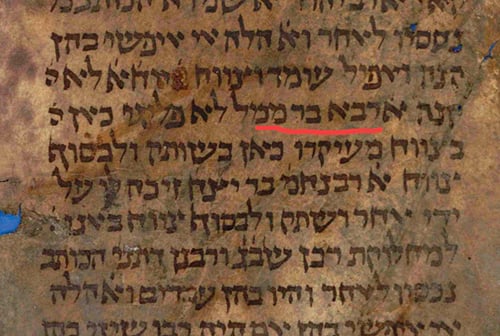
What does the phrase וְהָוֵינַן בַּה— “and we discussed it”— truly mean? It appears in Bava Batra 138. My usual approach is that the phrase represents a hyperlink in that ancient hypertext, the Talmudic corpus. Yet that doesn’t seem to work in our sugya. Let us explore some instances of וְהָוֵינַן בַּהּ and see where it takes us.
Approach (A): Consider Brachot 35b. A separate blessing was established for wine coming from grapes, but not for oil coming from olives. Mar Zutra (a colleague of Rav Ashi, sixth-generation Amora) explains that this is because wine nourishes (זָיֵין) while oil does not. The Talmudic Narrator objects that there is a Mishna that one who vows against nourishment (מָזוֹן) is permitted water and salt. “And we discuss there,” in Eruvin 30a, that this contradicts something Rav and Shmuel said (that the mezonot blessing only applies to food deriving from the five species of grain), and (second-generation) Rav Huna resolves the Mishna by explaining that he said ״כׇּל הַזָּן עָלַי״—” anything that nourishes me” is prohibited. End quote. Therefore, emend Mar Zutra’s answer to be that wine satisfies (סָעֵיד) while oil does not. This amended answer has its own problems in turn.
This cross-reference and quotation is a ha’avarah, a transferred sugya, made explicit. The sugya is primary in Eruvin, where the Mishna itself appears. The narrator in Brachot is aware of this other Eruvin sugya and depends upon the conclusion there to pose a question and adapt what local Amoraim said. Thus it is dependent upon, and written some time after, all of the Amoraim in Eruvin. Reacting as it does to Mar Zutra, it is also sixth generation or later. Being Stammaic, it indeed is probably later. Note that the phrase וְהָוֵינַן בַּהּ doesn’t appear in Eruvin 30.
Approach (B): Consider Brachot 45a, Rav and Rabbi Yochanan argue whether two people, rather than three, who ate together are allowed to optionally form a zimmun. It is unclear which Amora took which position. In Brachot 45b, the Talmudic narrator first tries to associate Rav with a position but rejects the proof. Then he tries to associate Rabbi Yochanan with disallowing a zimmun. After all, (third-generation) Rabba bar bar Chana cited Rabbi Yochanan that regarding two who ate together, one can bentch and thereby the other fulfills his obligation. And, as we discussed, this teaches us no novelty, because we already know the principle of shomea ke’oneh, one who hears it is as if he responded (alternatively: spoke up himself). Rabbi Zeira explained that this teaches us that they don’t say a zimmun. The Talmudic narrator concludes: We have resolved that Rabbi Yochanan maintains this position.
In this case, I’m unable to find the parallel sugya. If it derives from some known discussion, it was one that was available in the immediate context, which the Talmudic narrator is cannibalizing. Since it was so proximate, there was no need to subsequently repeat the same Amoraic analysis.
Alternatively, there never was a parallel sugya. Instead, וְהָוֵינַן בַּהּ means “Please bear with me, because the proof will take time to develop.” Thus to tie Rabbi Yochanan with a position, the narrator cites Rabbi Yochanan’s statement. However, that statement alone won’t prove it. Instead, an elaborate analysis of that source is required, by asking a question and an Amora resolving it. Thus, approach (B) is a request for patience. The proof isn’t immediate, but keep reading, and we’ll get to the compelling proof.
When encountering an וְהָוֵינַן בַּהּ, I’ll examine the parallel texts. My impression, formed by studying many such instances, is that these parallels generally exist. One primary sugya will lack וְהָוֵינַן בַּהּ; the others will. However, I’ve never conducted a comprehensive survey. That leads me to adopt approach (A). Of course, approach (B) is also absolutely true, that the purpose of וְהָוֵינַן בַּהּ is that the proof is elaborate. Otherwise, something simpler, like והאמר or כדאמר would be used.
Our Sugya
Our sugya is difficult, straddling the evidence for approaches A and B. Rav Nachman wishes to teach that if Reuven transfers to Shimon using Levi to acquire on Shimon’s behalf, if he initially was silent and subsequently protested, we’ve arrived at the dispute between Rabban Shimon ben Gamliel and the Sages (Tanna Kamma). To elaborate on this, there’s a baraita discussing Reuven writing a document granting his property to Shimon and Shimon protesting that he doesn’t want it. That protest is ignored. Rabban Shimon ben Gamliel says that as soon as Shimon says “I don’t want them,” Reuven or his heirs have already acquired them.
Quoting the baraita isn’t enough. וְהָוֵינַן בַּהּ, we discuss it, according to the Tanna Kamma, even if he stands throughout shouting, it works?! Rava, or alternatively Rabbi Yochanan, explains that regarding continual shouting, all agree Shimon doesn’t acquire; if he was initially silent and later protests, all agree he does acquire. The argument is essentially the same case as Rav Nachman bar Yitzchak set out, transfer via a third party plus initial silence and subsequent protest.
This resolution was surprising to me. I’d expected that Rav Nachman bar Yitzchak was only focused on the aspect of שָׁתַק וּלְבַסּוֹף צָוַוח and was saying that transfer via an intermediary was parallel to the baraita’s transfer via a document, not that we should transform the baraita’s case into his own case.
Regardless, the explanation of how fifth-generation Rav Nachman bar Yitzchak’s case approaches the dispute of the Tana Kama and Rabban Shimon ben Gamliel does not end with quoting the baraita where they argue. Rather, it relies on the explanation of the baraita by Rav Nachman bar Yitzchak’s teacher, fourth-generation Rava, or by the much earlier Amora from the Land of Israel, Rabbi Yochanan.
Our Sugya’s Parallels
Chullin 39b is parallel, where the above baraita, accompanied by the objection and Rava / Rabbi Yochanan’s answer is again quoted, using וְהָוֵינַן בַּהּ. (The Vilna, Venice and Soncino printings have Rabba but the manuscripts have Rava.) This is all quoted in explaining Ravina, that the Sages didn’t state permission regarding the animal in the incident in Caesarea because of Rabban Shimon ben Gamliel’s honor. There was a similar וְהָוֵינַן בַּהּ regarding Rav Sheizvi’s answer there, so Chullin doesn’t seem to be the primary sugya.
A third parallel sugya is Keritot 24b. Rabbi Shimon ben Lakish says that if Reuven gives a gift to Shimon and Shimon declines, anyone can rush up and acquire it. Among the rebuttals to Reish Lakish is this baraita, where his position works with Rabban Shimon ben Gamliel but not the Sages. The challenge is resolved, but Rava / Rabbi Yochanan’s analysis isn’t quoted.
The very phrase וַאֲפִילּוּ עוֹמֵד וְצוֹוֵחַ appears two other times. In Bava Kamma 112b, Rava rules that a court ratifies a document in the absence of a litigant, even if the other litigant screams his protest. Finally, in Bava Batra 137b — that is, immediately preceding our sugya — Rav Yehuda said that Shmuel said: If one writes a document granting his property to another, and the other says I don’t want it, he nevertheless acquires it, even if he’s standing and shouting in protest; but Rabbi Yochanan said that he doesn’t acquire it. To this, Rabbi Abba bar Mamel, a second- and third-generation Amora of the Land of Israel, and Rabbi Yochanan’s student, responds that Rav and Shmuel don’t actually argue, and then presents the distinction about protesting immediately vs. only after a delay. This isn’t precisely the distinction above, which has the (surprising) aspect that the acquisition was also via a third party. Tangentially, Rabbi Abba bar Mamel can also be called Rava bar Mamel, as appears here in Firkovich 190.
I feel quite uncertain here as to the primary sugya and how approach (A) or (B) applies. This is an elaborate analysis but also a parallel sugya. I’m not sure if Chullin or Bava Batra should be primary.
However, my nagging thought is that theTalmud’s own uncertainty in ascribing the analysis to Rava or Rabbi Yochanan is because the primary sugya is actually the immediately preceding one, on Bava Batra 137b, so approach (A) pertains. “Rava” could be Rava bar Mamel, who said most of those words but attributed to Rav Nachman bar Yitzchak’s own teacher Rava. Rabbi Yochanan could be dragged in because he appears in context. The surprising additional aspect of זִיכָּה לוֹ עַל יְדֵי אַחֵר could be a Stammaic insertion to adapt to the local case, perhaps unnecessarily.
Rabbi Dr. Joshua Waxman teaches computer science at Stern College for Women, and his research includes programmatically finding scholars and scholastic relationships in the Babylonian Talmud.








